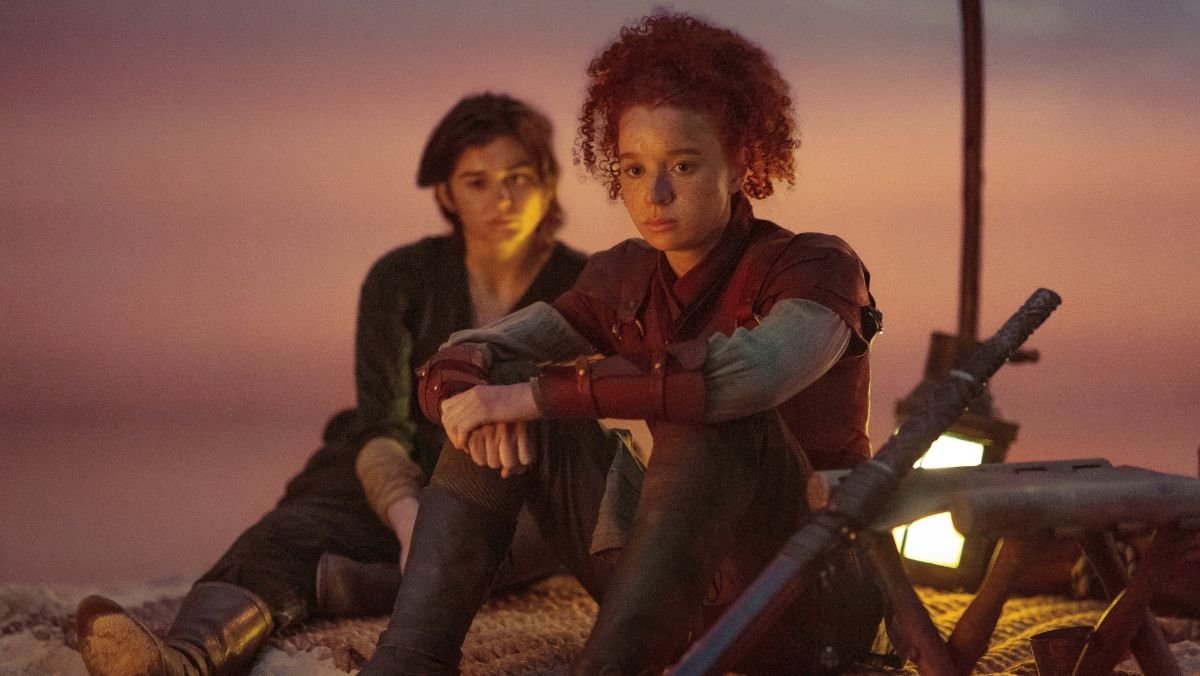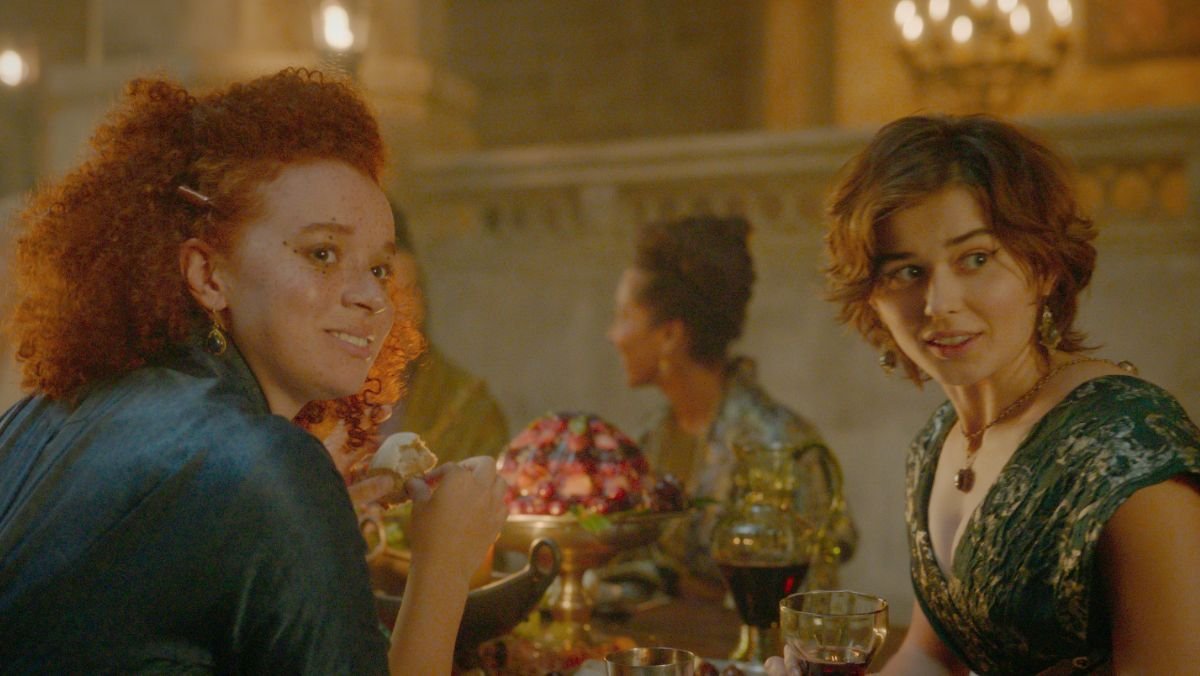In May 2022, we got our first glimpse at footage from Lucasfilm’s Willow TV series. The trailer brought back Warwick Davis’ titular hero and that earworm of a theme song along with a sense of how the original film’s magical world would expand in an epic TV series. But, for certain viewers with a penchant for keeping an eagle eye out for any potential signs of queerness (it’s me, hi, I’m the problem), the most strikingly significant moment was a “blink-and-you’ll-miss-it” frame of seemingly-romantic tenderness between two women. Could it be? Could the new Willow be kinda gay?! As Willow season one comes to a close, the answer to that question is a loud and resounding yes with Kit and Jade’s romance. And that is in large thanks to Willow doing what a fantasy should do: pushing back against the heteronormative systems of our real world.
That moment from the trailer wasn’t queerbaiting, which often shows a seemingly romantic scene only to have it be something different in the show’s context. It also wasn’t a quick kiss between background characters that could easily be lifted out if it bothered someone. It gave a teaser to a real honest-to-goodness moment of intimacy between two lead characters. Willow introduces tomboy princess Kit Tanthalos (Ruby Cruz) and her knight-in-training gal pal Jade Claymore (Erin Kellyman). As the series progressed, it became unambiguously clear that these two are lesbians in love with each other.
To those who haven’t been obsessively searching for queer content in their fantasy media (again, hi), it may not seem like such a shock that this relationship exists the way it does in Willow. But despite fantasy’s recent major resurgence in popularity, finding positive onscreen depictions of queer romance in the genre still feels like a quest in and of itself. Fantasy stories present magical worlds where wondrous things are possible; however, they often feel locked into the overall cultural mores and righteousness of the real-world eras and cultures their authors inhabit. As a queer fan of this genre, the absence of people like me from those stories often give the sense that queer identities are disposable. Or even worse, that queer people are simply not welcome.

In some cases this is intentional. Despite being a fictional world with dragons, George R.R. Martin’s Westeros from Game of Thrones does often intentionally draw from real-world cultural inspirations. Its Faith of the Seven is a thinly veiled representation of historical Catholic, at times even Inquisitorial, Christianity. While the text isn’t homophobic per se, the Westerosi culture it depicts very much is. Queer characters such as Renly Baratheon and Laenor Velaryon must hide their gayness due to the risk it could bring to them. This is clearly conscious commentary on real-world homophobia. A condemnation of the culture, not the people who face oppression because of it.
Other recent fantasy shows struggle with adding queer depictions due to a complete absence from their source material. Romance in general is not a pressing issue in Tolkien’s Middle-Earth books. It’s mostly relegated to mentions of marriages within the texts’ many, many appendixes. Those adapting The Lord of the Rings to the screen already must do a lot of work to flesh out the heterosexual love stories within them, let alone adding layers of gay to the mix.
Similarly, Prime Video’s The Wheel of Time took a few steps, such as playing up the “pillow friends” relationship between Moiraine (Rosamund Pike) and Siuan (Sophie Okonedo). But the Wheel world has a hard line of binary gender concepts built into its magic system. Adding in trans characters that break gender boundaries would likely complicate the story so much that they’d require entire stories unto themselves. It is a needlessly limiting construct in a world full of magic.

The Willow TV series put itself in a unique position to push the sexuality envelope within the genre. The 1988 film of the same name shows a world in ruins, crushed under the thumb of a despotic sorceress, Bavmorda. This meant we learned very little about the customs and culture of the society. However, the show presents a world trying to mend, to rebuild communities in the decades following Bavmorda’s defeat. This gave the creative team the perfect blend of using names and a known story to draw from while almost having an almost blank slate to build out a new fantasy world. And it is one that avoids subscribing to a 1980s standard of “decency.”
What is so absolutely refreshing about Kit and Jade’s love story in Willow is how utterly unremarkable it is. Other characters comment on the obvious sexual tension between the two; however, it’s never couched in the fact that both characters are women. The central conflict in the romance revolves around both characters’ awareness of their respective duties in the world. Kit, as a princess, rebels against the expectation that she must marry fellow royal Graydon (Tony Revolori).
Meanwhile, as a commoner knight, Jade is an unsuitable marriage for the purpose of solidifying any potential allegiances or treaties, at least at the start of the series. This pair fits so easily into a class-clashing friends-into-lovers trope. From the first episode, and teased with a kiss from Kit, they never even feel like a “Will they or won’t they?” Instead, it’s more of “When will they get to it already?” When Jade finally says “Shut up and do something about it,” the audience is in total agreement.

Fantasy worlds don’t have to be completely idealistic. Tales in otherworlds do allow creators the freedom to take elements of the real world and heighten them in ways that regular, non-genre fiction might not. It can be valid and often cathartic to see characters dealing with some of the same issues that we struggle with and overcoming them. It gives hope that while we may not sling spells or swing swords, we might too have a chance at overcoming our challenges. But seeing a fantasy world where two lead characters are just allowed to be queer and be in love is such an utter breath of fresh air. It is a welcome change to an often exhaustive sense of erasure.
The fictional cultures of the Willow series aren’t perfect by any means. Societal gender roles still cause conflicts for both Kit and Jade. And revelations about Jade’s own history drop seeds of future conflict with Kit’s family and even their kingdom. And you know, evil monsters and stuff. Eschewing homophobia from this particular tale doesn’t undercut drama or tension from the story. But it does allow it room to breathe and grow organically rather than become the entire focus of the narrative.
Willow‘s fiction allows for an effortless depiction of Kit and Jade’s lesbian love story. In fact, it almost makes one forget that there was likely a behind-the-scenes battle to make it happen. The culture war continues to put queer identities more in the crosshairs of what accounts for decency. Therefore, it matters that those creating media do the hard work of fighting for positive and caring depictions of rainbow romance that can’t easily be shaken from the spotlight, or from society.

